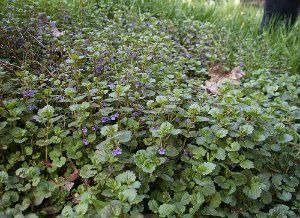Description: Ground Ivy, scientifically known as Glechoma hederacea, is a creeping perennial herb that belongs to the mint family (Lamiaceae). Recognized by its rounded, scalloped leaves and small, tubular purple flowers, Ground Ivy often forms dense mats in shaded or moist areas. Despite being native to Europe and Asia, it has become a widespread and invasive plant in North America.
Habitat and Distribution:
Ground Ivy thrives in shaded, damp environments, making it a common sight in lawns, gardens, and wooded areas. It spreads rapidly through creeping stems, rooting at the nodes, making it a challenge to control once established.
Physical Features:
- Leaves: The leaves are heart-shaped with scalloped edges, and they emit a distinct minty aroma when crushed.
- Flowers: Small, funnel-shaped, purplish-blue flowers bloom in clusters in late spring to early summer.
Invasive Characteristics:
Ground Ivy's ability to form dense mats and spread aggressively through creeping stems can quickly overtake other vegetation, making it a nuisance for gardeners and homeowners. Its aggressive growth can smother grass and desirable plants in lawns and landscapes.
Control Methods:
- Manual Removal: Hand pulling or using a garden tool to dig up Ground Ivy can be effective for small infestations. Ensure that the entire root system is removed to prevent regrowth.
- Mulching: Applying a thick layer of organic mulch can help suppress Ground Ivy growth. Mulching not only smothers the existing plants but also creates a barrier to prevent new growth.
- Herbicides: Selective herbicides designed for broadleaf weed control can be effective against Ground Ivy. Carefully follow the application instructions to avoid harming desirable plants.
Competition with Other Plants:
Planting and encouraging the growth of other shade-tolerant ground covers can help compete with Ground Ivy. Examples of competing plants include:
- Periwinkle (Vinca minor): This evergreen ground cover forms a dense mat, inhibiting the spread of Ground Ivy.
- Dead Nettle (Lamium spp.): With its vigorous growth, dead nettle can outcompete Ground Ivy in shaded areas.
Preventing Spread:
- Regular Monitoring: Regularly inspecting and promptly addressing any new growth of Ground Ivy can prevent it from becoming established.
- Improving Lawn Health: Maintaining a healthy lawn through proper watering, fertilization, and aeration can help create conditions less favorable for Ground Ivy.
Promoting Native Plants:
Encouraging the growth of native plants in shaded areas can provide competition and reduce the chances of Ground Ivy dominance.
In conclusion, controlling Ground Ivy requires a combination of manual, chemical, and preventive measures. By understanding its invasive characteristics and implementing effective strategies, it is possible to manage and mitigate the impact of this persistent plant on landscapes and gardens.



